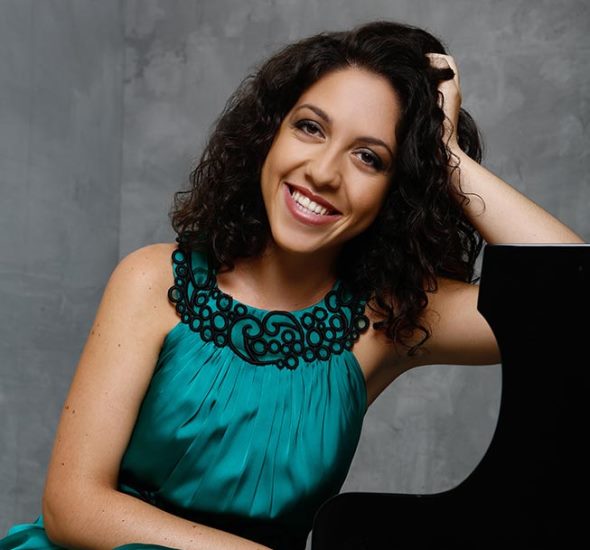Pianist Beatrice Rana makes impressive debut with display of technical prowess, fluent style

Pianist Beatrice Rana: An astonishing mix of delicacy, fluidity and seemingly effortless speed. (Photos by Marie Staggat)
Review: Pianist Beatrice Rana in recital Feb. 24 at Orchestra Hall.
By Hedy Weiss
I confess I knew nothing about the 26-year-old Italian pianist Beatrice Rana before she made a phenomenal Symphony Center debut on Feb. 24. What initially lured me to the program, part of the center’s vaunted piano series, was her choice of repertoire: Chopin’s 12 Etudes, Op. 25, ground-breaking, mood-shifting works from the 1830s that require the most nuanced interpretation and technical brilliance; Ravel’s “Miroirs,” his luminous, exquisitely poetic and aptly titled 1905 work; and excerpts from Stravinsky’s career-making 1909 ballet “The Firebird,” in a fabulously flamboyant arrangement created in the 1930s by the Italian pianist and teacher Guido Agosti.
Rana held the audience at rapt attention. I doubt anyone who heard her will want to miss any of her future concerts, whether solo or with an orchestra (hopefully the Chicago Symphony). She is an extraordinary artist, in both her technical and interpretive skills.
Born into a family of musicians, Rana began her piano studies at the age of four, and at nine made her orchestral debut with a performance of Bach’s Keyboard Concerto in F minor. In 2011 she won first prize and all the “special jury prizes” at the Montreal International Competition, and in 2013 she won the Silver Medal and Audience Award at the 14th Van Cliburn International Piano Competition. Her 2017 recording of Bach’s “Goldberg Variations” (released on the Warner Classics label) led to a 30-city international tour and to her being named Gramophone Awards Young Artist of the Year.
Rana arrived onstage in a simple but elegant emerald green gown, took her seat at the piano, and without any theatrics (a notable characteristic of her entire performance) she immediately captured the rippling wonders of Chopin’s Etude No. 1 in A-flat with easy virtuosity. Her approach suggested Hamlet’s advice to an actor to deliver his lines “trippingly on the tongue.” And her impossibly fleet but strong fingers went on to fly through the remaining 11 Etudes of the cycle with a uniformly astonishing mix of delicacy, fluidity, ferocious but seemingly effortless speed, impeccably clear articulation and great dynamic range.
It would be difficult to think of a more ideal interpreter of Chopin’s multifaceted demonstration of acrobatic poems for the piano in which tempos shift imperceptibly and eddies of diaphanous sound surge into powerful storms in the blink of an eye.
The second half of Rana’s program began with Ravel’s “Miroirs,” a suite of five magically moody pieces that suggest they were composed by a painter working with the most delicate brushes as varying currents of air spun around him. In fact, each was dedicated to a fellow member of the group of innovators in many different art forms who dubbed themselves “the hooligans.” In many ways “Miroirs” could be seen as an early 20th-century riff on Chopin’s influential Etudes.
The opening piece, “Noctuelles” (French for “moths”), opened with an instant fluttering of fingers to which Rana brought a playful, dreamlike quality. It was followed by “Oiseaux tristes,” with its airy, plaintive sound; bravura renderings of “Une barque sur ‘l’océan,” a ferociously difficult evocation of ocean waves, and “Alborado del gracioso,” with its lush Spanish themes; and then the hauntingly lovely “La vallée des cloches,” with its shimmering sound of chimes in the distance. Rana captured each musical poem to perfection.
Finally, the Stravinsky “Firebird,” another astonishing but very different showpiece that Rana played to thrilling effect. The Russian composer possessed a powerful sense of the theatrical and ritualistic, often drawing on folk tunes and injecting them with his own jarringly modern twist on their rhythms. Stravinsky wrote “The Firebird” (1910), his breakout work, for the legendary impresario Serge Diaghilev and his Ballets Russes.
Agosti’s piano transcription begins with the pounding, fearsome “Danse infernale,” to which Rana brought a mesmerizing percussive power. Just as convincingly she shifted to the dreamily exotic “Berceuse” (lullaby), and then to the rousing finale.
Each of the pianist’s performances inspired a moment of stunned awe followed by a rapturous standing ovation.She rewarded her audience by playing two encores that brought the recital back full circle to Chopin, with exquisite renderings of the composer’s brief, swirling Prelude in F-sharp and the tempestuous Prelude in B-flat minor.
Related Link:
- Beatrice Rana – Notes and tracks from the BBC: Read and listen here



